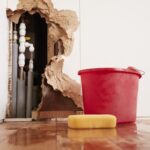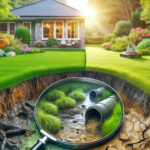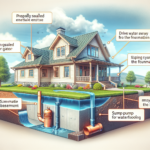Water damage in homes, often resulting from leaks in plumbing fixtures such as toilets, faucets, and washing machines, can lead to significant financial and emotional distress. The insidious nature of water damage means it can go unnoticed until it has caused major issues, from structural damage to the fostering of unhealthy mold growth. Preventing water damage is not only about safeguarding possessions but also about ensuring the structural integrity of the home and the health of its inhabitants. Recognizing the importance of this issue is the first step towards mitigating potential risks and maintaining a safe living environment.
This article aims to provide homeowners with comprehensive strategies to prevent water damage, emphasizing the importance of understanding one’s home plumbing system, conducting regular maintenance, and installing preventative measures. It also highlights the need to protect homes against cold weather conditions, which can lead to frozen pipes and subsequent bursting, causing flooding and extensive water damage. By following the guidance on maintaining appliances like dishwashers, showers, tubs, and using a sump pump effectively, readers will be equipped with the knowledge needed to safeguard their homes against the often-catastrophic consequences of water damage.
Understand Your Home’s Plumbing System
Understanding your home’s plumbing system is crucial to prevent water damage effectively. Here are the key areas to focus on:
Locate and Inspect the Main Water Shut-off Valve
The main water shut-off valve is a critical component in your home’s plumbing system. Typically located along the perimeter of the house facing the street, this valve can also be found in the basement, near the water meter, or outside near the curb in a buried meter box. Knowing the exact location of this valve is essential, as it allows you to quickly halt the water supply in emergencies, preventing further damage. Homes without basements might have the shut-off valve near the water heater or under the kitchen sink. It’s advisable to familiarize yourself with the valve type—be it a gate valve or a ball valve—and ensure it operates smoothly.
Learn About Individual Appliance Shut-offs
In addition to the main shut-off valve, individual shut-off valves, or fixture supply stops, are present for appliances and fixtures such as toilets, sinks, and washing machines. These valves allow you to stop the water flow to a specific area without affecting the entire house. Typically located behind or beneath the appliance, these valves can be turned clockwise to halt water flow. It’s important to locate these valves and understand their operations to quickly address leaks or perform maintenance without disrupting the entire home’s water system.
Check Water Pressure and Usage for Early Warning Signs
Maintaining the right water pressure is vital for the health of your plumbing system. Too high pressure can stress pipes, leading to leaks or bursts, while too low pressure can hamper the effectiveness of your household water system. The ideal range for water pressure in most homes is between 40 to 60 psi. You can measure water pressure with a gauge available at hardware stores. Additionally, keep an eye on your water usage through the meter to spot any unusual increases, which could indicate leaks or other plumbing issues. Installing a pressure regulator can help manage water pressure to safe levels, protecting your plumbing and reducing the risk of water damage.
By understanding these aspects of your home’s plumbing system, you can take proactive steps to prevent costly repairs and water damage. Regular checks and maintenance of the main and individual shut-off valves, along with monitoring water pressure, will ensure your plumbing system functions efficiently and remains in good condition.
Conduct Regular Maintenance
Regular maintenance is essential to prevent water damage in homes. By routinely checking and maintaining plumbing systems and appliances, homeowners can avoid costly repairs and potential disasters. Here are some crucial maintenance practices to incorporate:
Inspect Appliance Hoses and Faucets
Appliance hoses, such as those connected to washing machines, are common culprits for water damage. Inspecting these hoses monthly for any signs of wear such as blisters, cracks, or loose connections is crucial. The areas most prone to failure are where the hose bends or near the connection points. It is recommended to replace washing machine hoses every 3-5 years or immediately if any damage is visible. Additionally, installing burst-proof hoses, which are often reinforced with wire or have an auto-shutoff feature, can significantly mitigate the risk of a burst.
Faucets and showerheads should also be checked regularly. Look for leaks, and ensure that handles do not leak when turned off. Under-sink pipes should be inspected for any signs of dripping or leaks, which can be early indicators of potential problems.
Maintain and Check Plumbing Fixtures Regularly
Toilets, sinks, and tubs are integral to a home’s plumbing system and require regular checks. For toilets, watch for subtle leaks by placing a few drops of food coloring in the tank and checking if the color appears in the bowl after about 30 minutes. This could indicate a failing flapper or other internal components needing replacement.
Regularly cleaning your shower heads and faucets can prevent build-up and ensure they function efficiently. For shower heads, an easy cleaning method is soaking them in vinegar overnight to remove mineral deposits, which can affect water flow.
Inspect and Upgrade Pipes and Appliance Hoses
Over time, pipes and appliance hoses can suffer from wear and tear due to high water pressure and poor water quality, which can lead to corrosion and leaks. Inspecting these components can help identify issues before they result in significant damage. If your home uses well water or has hard water, consider installing hose washers with built-in screens to catch any sediment and prevent clogging.
Additionally, ensure that all plumbing connections, including those on appliances like dishwashers and water heaters, are secure and not showing signs of corrosion or damage. Replacing old or worn-out hoses and pipes with high-quality materials can prevent leaks and water damage.
By integrating these regular maintenance tasks into your routine, you can significantly reduce the risk of water damage and maintain a safe and healthy living environment.
Install Preventative Measures
Installing preventative measures is a critical step in protecting your home from water damage. By integrating advanced systems and devices, homeowners can significantly reduce the risk of leaks and the costly damages that can follow. This section outlines essential preventative solutions including leak detection sensors, automatic shut-offs, and emergency pressure release valves.
Install Leak Detection Sensors
Leak detection sensors are invaluable tools for early identification of potential water leaks, which can prevent extensive damage and costly repairs. Simple DIY devices, such as battery-operated discs, can be placed in areas prone to water accumulation like under sinks, near toilets, or around water heaters. These sensors are designed to detect even small amounts of water, triggering an alarm and sending notifications to your smartphone through Bluetooth or Wi-Fi connections. For broader coverage, consider installing sensors with extension cables or purchasing multiple units to place throughout your home.
Set Up Automatic Shut-Offs
Automatic shut-off systems provide an advanced level of protection by automatically cutting off the water supply when a leak is detected. These systems can be integrated into your home’s plumbing and are particularly useful in preventing major water damage when you are not at home. Devices such as the Flo by Moen and the Guardian by Elexa offer both professionally installed and DIY options. These systems not only detect leaks but also monitor water pressure and flow rates, providing comprehensive protection against various plumbing issues.
Consider Emergency Pressure Release Valves
Emergency pressure release valves (PRVs) are critical in managing the pressure within your home’s plumbing system. These valves are designed to open and release excess pressure if it exceeds safe limits, thereby preventing pipe bursts and related water damage. PRVs are particularly important in systems that handle high-pressure or flammable fluids, as they can divert these potentially dangerous fluids safely. Homeowners should ensure that PRVs are properly installed, maintained, and regularly tested according to industry standards to guarantee their effectiveness.
By incorporating these preventative measures, homeowners can safeguard their properties against the risks of water damage, ensuring peace of mind and the longevity of their home’s structural integrity and plumbing systems.
Protect Against Cold Weather
Subzero temperatures can significantly increase the risk of pipes freezing and bursting, leading to extensive water damage. This section provides essential steps to protect your home’s plumbing during cold weather.
Prevent Pipes from Freezing
To mitigate the risk of frozen pipes, which can burst and cause significant damage, homeowners should take several precautions. First, it’s crucial to maintain a minimum indoor temperature of 55 degrees Fahrenheit, even when the property is unoccupied. For pipes located in basements, attics, garages, or along exterior walls, additional measures are necessary. Wrapping pipes with insulation, such as foam lagging, can prevent freezing. This simple step is cost-effective, with insulation often costing as little as 50 cents per linear foot at hardware stores.
Another effective strategy is to keep water faucets dripping slightly during extremely cold temperatures. The continuous water movement helps prevent the pipes from freezing. It’s also advisable to open cabinet doors under sinks to allow warmer air to circulate around the plumbing.
Insulate Exposed Pipes
Insulating exposed pipes is a critical step in safeguarding your home against the cold. Utilize materials like foam rubber or fiberglass sleeves to cover exposed pipes, particularly those in unheated or vulnerable areas of the home. For pipes that run through cold zones within the walls or floors, it’s beneficial to pack the entire cavity with insulation. This not only prevents freezing but also enhances overall energy efficiency by keeping the heat within the home.
For added protection, consider installing electric heat tape around pipes. This tape is controlled by a thermostat, which activates the heating element when temperatures drop to a critical level. However, it’s important to note that electric heat tape requires a reliable power source and will not function during a power outage.
Keep the Heat On If Away During Winter
If you plan to be away from home during the winter months, it’s essential to keep the heating system active to prevent the interior from dropping to temperatures that could cause pipes to freeze. Set the thermostat to at least 55 degrees Fahrenheit and consider using a smart thermostat that can be monitored and adjusted remotely.
For homes with solar water heaters, special precautions should be taken to prevent freezing. Ensure that these systems are adequately insulated and consider draining them if extremely low temperatures are forecasted. Additionally, shutting off the water supply and draining the system can prevent freezing if the home will be unoccupied for an extended period.
By implementing these measures, homeowners can significantly reduce the risk of water damage due to frozen and burst pipes during cold weather.
Conclusion
Throughout this article, we’ve explored the critical steps homeowners can and should take to prevent water damage and protect their homes. From understanding and maintaining your home’s plumbing system to installing preventative measures and preparing for cold weather, these strategies offer comprehensive guidance to mitigate the threat of water damage. Emphasizing the significance of regular maintenance and the adoption of proactive measures ensures the structural integrity of your home, safeguarding both your emotional and financial investment.
The journey to effectively shield your residence from water damage requires diligence, awareness, and the implementation of the outlined recommendations. By taking these actions, homeowners can rest assured that they have significantly minimized the risk of water damage, thus contributing to the creation of a safer, more secure living environment. As the implications of water damage extend beyond immediate repair costs to include long-term structural and health issues, the importance of adopting these preventative strategies cannot be understated.
FAQs
- What steps can I take to prevent water damage to my house?
To shield your house from water damage, start by maintaining the exterior. Seal windows with caulk to prevent water seepage and inspect your roof for any signs of damage or aging shingles, repairing them as necessary. Additionally, ensure that downspouts and rain gutters are free of debris to allow proper water flow. - What are effective strategies to safeguard my home against water leaks?
There are several proactive measures you can take to protect your home from water leaks:
- Familiarize yourself with the location of the stopcock.
- Regularly check for any leaks.
- Ensure your sump pump is operational.
- Keep gutters clear of debris.
- Conduct thorough inspections of your roof both inside and out.
- Take steps to prevent pipes from freezing.
- Insulate any exposed pipes.
- Consider installing a water leak detection device.
- How can I prevent water from seeping into my home?
To prevent water seepage into your home, consider the following tips:
- Regularly check hoses and faucets for wear.
- Clean out gutters and downspouts to ensure they are unobstructed.
- Keep trees around your home trimmed to prevent overgrowth near water drainage areas.
- Regularly look for any signs of leaks, mold, or cracks.
- Monitor your home’s water pressure to detect unusual changes.
- Keep an eye on your water bill for unexpected increases, which can indicate leaks.
- Know how to shut off your water main in case of an emergency.
- Inspect your roof and chimney for potential water entry points.
- What is the primary cause of water damage in homes?
The most common cause of water damage in homes is damaged pipes. Plumbing issues, particularly in older properties, can arise from blockages or other damages. To prevent these issues, regularly inspect for signs such as cracks, bulges, stains, or moisture on ceilings and floors, which can indicate plumbing failures.
We represent home and business owners and have vast experience with the following types of claims:
- Fire and smoke damage claims
- Water damage claims
- Flood damage claims
- Theft and vandalism damage claims
- Snow and ice damage claims
- Building collapse claims
- Wind and hail damage claims
- Catastrophic damage claims
- Roof leaks
- Blown off shingles & siding
- All plumbing leaks
- Toilet overflow
- Burst Pipes
- Frozen Pipes





